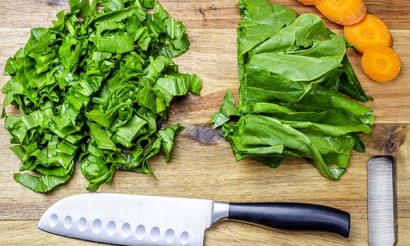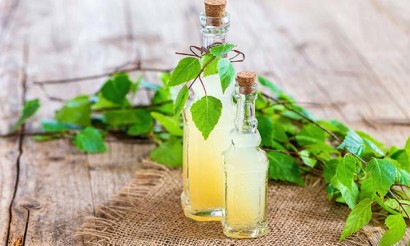Olives and olives: what's the difference?
Purple, green or brown - olives are considered a delicacy for a real gourmet. Tender flesh and subtle flavor allow combining them with vegetables, cheeses and seafood. Olives are eaten marinated or canned, added to pizza and vegetable pies. But when people choose olives they often face the question: what is the difference between green and black olives? What are the specifics of the fruit and their positive effects on the body?
- What are olives and olives
- Popular Olives
- What is the difference between an olive and an olive
- What is healthier: olives or black olives
- Health benefits and harms of olives
- For Women
- For Men
- For Children
- Harm and Contraindications
- Cooking Applications
- Bruschetta
- Tapenade
- Focaccia
- Seafood salad
- With meat
- How to choose green and black olives
- How to store olives
- Interesting facts about black and green olives
What are green and black olives?
Contrary to common misconception, both olives and olives are the fruit of the same plant - a cultivated European Olive (a variety of oil-bearing trees, widespread throughout the south-eastern Mediterranean). They differ from each other only by color, which reflects the level of maturity of the fruit. Green olives are unripe fruits, black olives are ripe. Gradation into olives and olives is found only in Russia and the former Soviet Union. In all other countries both varieties belong to the same class - olives.
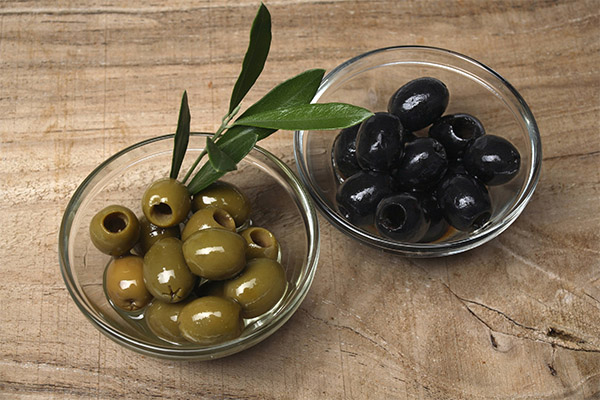
Popular varieties
Olives are divided into several varieties, based on their subsequent use:
- Table - designed to be eaten raw or canned.
- Oiled - used for extracting oil.
- Universal - suitable for adding to dishes and for oil extraction.
The variety of olives became possible thanks to the cultivation (breeding) of the olive tree. The technology has contributed to the crossing of different species, resulting in many varieties that grow around the world.
The most popular varieties of black olives
- Kalamon, Kalamata. The classic Greek variety, which is considered the most widespread on the entire southern coast, not only in Greece, but also in Italy. The name comes from the first city in which they appeared, Kalamata. And they grow on the Kalamona olive tree. These are large fruits of deep purple color with a very pronounced odor and aftertaste. They are harvested only when fully ripe, which guarantees all the richness of flavors. Kalamata is popular because of its fleshiness and large size. It is most often canned in wine or wine vinegar.
- Mavroelia. Small black olives, which are harvested strictly when they are ripe. If they are overripe, they will lose moisture due to the specifics of the variety. They are rarely used in their pure form, precisely because of their fastidiousness to external factors.
- Gaeta. This is an Italian subspecies, which fruits are characterized by small "wrinkles". Traditionally they are marinated in salt with a minimum of rosemary and other aromatic herbs.
- Alfonsos. Olives of this variety are recognized as one of the best. Smooth fruit, good tolerance to temperature fluctuations, fleshiness, thin, but deep flavor - the unique features of this variety. Alfonsos fruits show their flavors particularly well after a short marinating. They are served with cheeses and vegetables.
- Lugano. A favorite of many Italian varieties, famous for their natural brackish flavor. In case of canning, herbs and olive leaves are added.
Popular varieties of green olives
- Halkidiki. Greek olives, characterized by large fruits. They are harvested green, soaked in brine with herbs to soften. As a result, they acquire an unusual flavor. Their distinctive feature is a pronounced tartness, which, combined with fleshiness, makes them a great snack.
- Picholine. This variety of French olives, characterized by a salty, mild taste. The fruits are preserved with citric acid.
- Manzanilla. Spanish sort, suitable for canning and pickling. Has a not expressed spicy aftertaste, goes well with products in salads. Manzanilla fruits are medium sized, sold with or without a seed.
One of the most common green olives are Spanish olives. They are plucked strictly at a certain stage of maturity and steeped in an acidic brine for six months, due to which the fruits enrich their natural flavor and get a unique smell.
What is the difference between black olives and olives
Black olives have a strong flavor with nutty and fruity notes, they are most often used for extraction of olive oil. Green olives are a bit bitter, but are also famous for their piquancy.
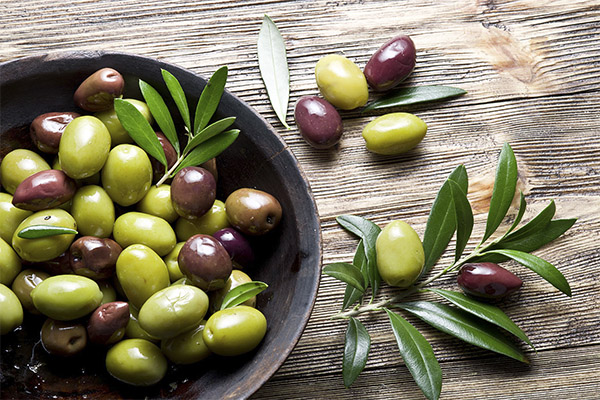
Black olives are divided into two large groups:
- Natural. These are fruits that get their color from the natural maturation. Their shade varies slightly depending on the variety from dark purple to brown.
- Colored. These olives are most commonly found on the shelves of domestic supermarkets. Their color is the result of the oxidation process: immature green olives are placed in a container of iron-enriched and brine, which softens them and gives them a special taste. Iron gluconate (food additive labeled E579) is used to stabilize the color. It is considered permissible, but it is not worth getting addicted to such a product, as a 300 ml can of olives has an iron concentration of 22,5 mg, which is several times higher than the daily rate.
What is more useful: olives or black olives
If you compare fruits that are not subjected to any external processing, their usefulness is about the same. Dyed olives are inferior to natural due to the presence of stabilizers and preservatives. Pigmentation of the fruit does not affect the amount of vitamins and minerals.
Benefits and harms of fruits for the health of the body
Olives are a unique product not only in terms of their taste, but also their composition. They contain unsaturated omega-6 fatty acids, which prevent the development of atherosclerosis and cardiovascular diseases. They also contain three types of fatty acids: lanolinic, oleic and linolenic, necessary for metabolic and regenerative processes. Olives strengthen the walls of blood vessels, reduce blood glucose levels and minimize the likelihood of blood clots.
A curious fact: Scientists have noted that Italian and Spanish women are less likely to get breast cancer due to the fact that they eat olives and natural cold-pressed olive oil daily. Residents of the Mediterranean are also among the long-livers precisely because of the massive love of olives.
Olives are rich in dietary fiber, which has a positive effect on the digestive tract. They improve peristalsis, help to normalize healthy intestinal microflora. The product also contains B vitamins, vitamin A, PP, E, phosphorus, sodium, calcium, potassium and magnesium. The substances in the fruit accelerate the healing of wounds and contribute to the natural cleansing of the body from toxins.
The pulp of the fruit contains:
- 9% fiber;
- 6% protein;
- 52% of fats, oils and pectins;
- 23% water.
Nutritionists recommend to pay attention to olives for elderly people as well, because they stabilize the liver and strengthen bone tissue. Eaten for a month 300 grams of black olives will be an excellent prevention of periodontal disease and the formation of gallstones.
Olives - an indispensable food against any kind of inflammation. They contain oleocanthal that blocks the synthesis of prostaglandins, substances that trigger inflammation in any location. Therefore, adding olives to the diet will help in the fight against arthritis and osteochondrosis.
For women
Women who care about the condition of their skin, hair and nails should add olives to their diet. They have a high concentration of vitamin E. It stimulates the production of collagen, the lack of which provokes the loss of elasticity of the skin. Vitamin A, also contained in fruits, nourishes skin and provides its elasticity. Linoleic acid prevents the loss of moisture and protects the epithelium from micro-cracks. Natural olive oil is considered one of the best alternatives to creams.
American scientists have classified olives as products that improve fertility. It means that the systematic use of olives at a woman improves hormone levels and there is a greater chance of getting pregnant.
For men
Men should also pay attention to olives because of vitamins E and A. They improve blood circulation, stimulate the flow of blood to the pelvic organs and increase sperm count. The fatty acids present in the fruit make blood vessels stronger, protecting them from heart attacks.
For children
Since olives are not sold in their pure form, they should not be given to children under 6 years of age. The reason is the high amount of salt and potential allergens in the marinade. And natural cold-pressed olive oil is ideal for babies, even the first year of life. It can be one of the first components of complementary foods.
Harms and contraindications
With the enormous benefits that olives have for health, their uncontrolled consumption is likely to bring more harm. This is due to the fact that the green fruits are not consumed fresh - they are in any case soaked in brine with salt or acid. A large intake of sodium in the body can provoke an increase in blood pressure. Therefore, if there is a choice in the store, it is better to give preference to products with a minimum concentration of salt or those manufacturers who use citric acid, wine vinegar and spicy herbs for this purpose.
But from olives and olive oil should be completely abandoned in cholecystitis, because they can provoke the secretion of bile. People who suffer from obesity, too, should be careful with the product because of its high caloric content (115 kcal per 100 g) and high concentration of fats.
Cooking Applications
In cooking, olives can be served as a separate dish (as a cold appetizer), and as a supplement to salads, side dishes, pasta. If they act as a separate product, they may have a bone in them. If olives are a component of a dish, it is better to buy pitted fruits. Stuffed olives can be found in stores, which can be a good addition to white wine and snacks. Salmon, tuna, anchovies, shrimp, capers, and rolled tomatoes are used as fillings.
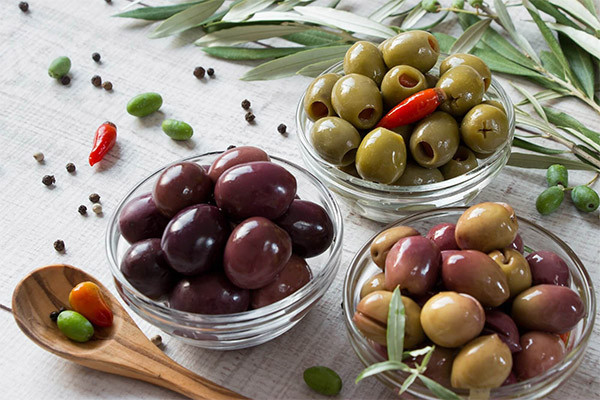
Bruschetta
Those who encounter natural green olives for the first time need to get used to their characteristic taste. Therefore, they should not be added immediately to familiar dishes. It is easier to start with accents: put a few pieces in a traditional vegetable salad or make bruschetta with them. This is a traditional Italian sandwich. The recipe for making it:
- You need to take a small slice of bread (ideally it should be ciabatta, but it can be replaced by rye bread or baguette), fry it in a dry pan or in the oven.
- Then rub it with a piece of garlic, add tomatoes, a few basil leaves, chopped olives and a splash of oil.
This is a classic technique that can be varied with salmon or Italian sausages if desired.
Tapenade
Olives are used to make tapenade, a thick sauce of anchovies, capers and olives. To do this, all the ingredients are ground with a blender to a thick sour cream. If desired, you can add basil or parsley. Ready sauce is perfectly combined with grilled vegetables.
Focaccia
Olives can be added to any baked goods, especially homemade focaccia. But only big fleshy pitted olives are good for that (green olives with a bone can also be used, but they have to be pitted beforehand). Finely chop the pulp and add to the dough at the kneading stage, give it the desired shape and bake. Olives give a fresh baked pastry amazing flavor.
Seafood salad
Olives go well with seafood as well. Salads with squid are especially delicious. For this, the squid should be boiled, cut, add garlic, olives, pepper and salt. As a dressing, it is best to use olive oil. Lovers of spicy flavor should try to make a salad with basil, pine nuts and green olives. Mix all the ingredients, season with oil and a little lemon juice.
With meat
An interesting solution would be a combination of olives, pasta and stewed meat. To prepare this dish, you need to fry the meat in vegetable oil, add tomatoes in their own juice, salt, pepper. Boil pasta, strain it and add it to the meat. Mix everything and add chopped olives.
How to choose green and black olives
Despite the large number of low-quality products, presented in stores, it is still possible to find a really high-quality olives. To do this it is necessary to take note of the following nuances:
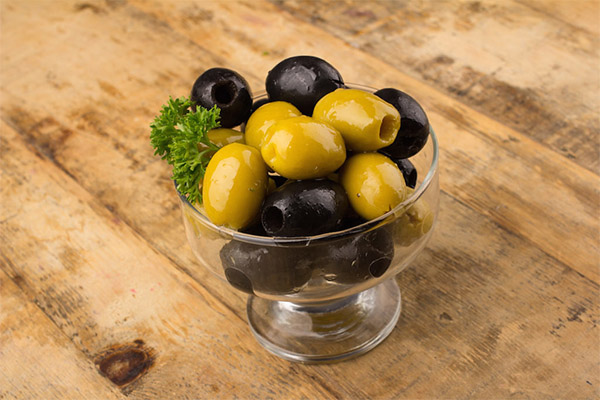
- It is better to give preference to olives in a glass jar. This will allow you to consider the fruit and their condition before buying.
- If only olives in tin cans are available, then be sure to review it for integrity and lack of dents.
- The shelf life of the product is from 7 to 12 months, which must be indicated on any package.
- The optimal composition: olives, salt and water. The addition of E579 indicates that they are dyed.
- It is necessary to specify the country of manufacture. Despite the fact that today there are olive trees even in the Krasnodar region, the best producers are considered to be Italian, Greek and Spanish companies. This is influenced not only by the climate, but also by the high standardization of production.
- Olives with seeds are considered to be of higher quality, so they cost more.
- A true black olive never has the same shade across the entire surface. Somewhere it may be darker, somewhere lighter. A total black color with no halftones is a sign that a dye has been used.
How to store olives
A closed jar can stand exactly as long as indicated on the label. But it should not be placed in the sun (even in the case of a metal container). Opened product requires more careful handling - these olives should be placed in the refrigerator and eaten within 3 days. Olives in a tin is better to transfer to ceramic or glassware. This is due to the fact that the inner surface of the tin container in contact with air quickly oxidizes, releasing potentially harmful compounds. Also, you should not pour the marinade - it will not let the fruit lose its shape.
Interesting facts about olives and olives

- The olive tree and its fruits are mentioned many times in the holy scriptures - the Old Testament and the Quran, which indicates their historical value.
- The cultivation of olives for the first time began more than 7000 years ago.
- The olive branch is a symbol of peace - it was sent to their enemies as a sign of agreement to end the war.
- Most of the olive factories are located in Spain, with Italy coming in second place.
- Olives are one of the main products imported from Crete.
- Olives are fruits, not vegetables or berries.
- The olive tree can reach a height of 15 meters, it belongs to the category of evergreen trees and can live up to 2000 years.
- The average life span of an olive tree is 200 to 650 years.
- The olive tree does not grow in the wild, only in plantations.
- The olive blossoms in May and is harvested in November-March.
- Fresh olives are not eaten because they contain the glycoside oleuropine. This gives them a strong bitterness. You can get rid of it only by soaking in brine.
- Olive oil is the only vegetable oil that can be consumed immediately after extraction without further processing.
- The oldest olive tree is located on the island of Crete. It is 4,000 years old and still bears fruit.
«Important: All information on this site is provided for informational purposes only. for informational purposes only. Before applying any recommendations, please consult with a health care professional. specialist before using any of the recommendations. Neither the editors nor the authors shall be liable for any possible harm caused by materials."







